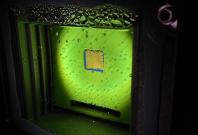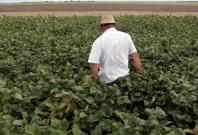 Scientists say that exoplanets with mass 2.7 percent of the Earth can be habitable and contain life-supporting materials.
Scientists say that exoplanets with mass 2.7 percent of the Earth can be habitable and contain life-supporting materials.
 The boy changed his T-shirt to a sort of tunic made out of a plastic garbage bag because it was getting so dirty.
The boy changed his T-shirt to a sort of tunic made out of a plastic garbage bag because it was getting so dirty.
 The study says coral reefs move to cool water to protect themselves in the looming threat of global warming.
The study says coral reefs move to cool water to protect themselves in the looming threat of global warming.
 Researchers have developed a new technique that can absorb carbon dioxide even down upto 400 ppm currently present in the environment.
Researchers have developed a new technique that can absorb carbon dioxide even down upto 400 ppm currently present in the environment.
 Researchers have found new strains of Human Adenovirus responsible for several diseases, including pneumonia and other life-threatening diseases.
Researchers have found new strains of Human Adenovirus responsible for several diseases, including pneumonia and other life-threatening diseases.
 Scientists from McMaster University have found some proof in Greece of the island of Naxos being occupied by Neanderthals and earlier humans at least 200,000 years ago - tens of thousands of years earlier than previously believed.
Scientists from McMaster University have found some proof in Greece of the island of Naxos being occupied by Neanderthals and earlier humans at least 200,000 years ago - tens of thousands of years earlier than previously believed.
 A novel citizen science project by seven grandmothers in New Caledonia reveals that there are a huge number of venomous reptiles in a popular swimming spot at Baie des citrons.
A novel citizen science project by seven grandmothers in New Caledonia reveals that there are a huge number of venomous reptiles in a popular swimming spot at Baie des citrons.
 Syngas, a widely used gas produced from fossil fuels, is an interesting alternative that can be made by an 'artificial leaf' with just sunlight, carbon dioxide and water. It can finally be used to develop liquid fuel.
Syngas, a widely used gas produced from fossil fuels, is an interesting alternative that can be made by an 'artificial leaf' with just sunlight, carbon dioxide and water. It can finally be used to develop liquid fuel.
 Research has shown that introducing fungi to wheat leads to a reduction in dependency on fertilizers as it provides nutrients to plants roots.
Research has shown that introducing fungi to wheat leads to a reduction in dependency on fertilizers as it provides nutrients to plants roots.
 Scientists who examined fossilized Moroccan Ampyx trilobites living 480 million years ago concluded that all early living species exhibited collective behaviour. They found that trilobites were most probably buried in positions oriented in the same direction.
Scientists who examined fossilized Moroccan Ampyx trilobites living 480 million years ago concluded that all early living species exhibited collective behaviour. They found that trilobites were most probably buried in positions oriented in the same direction.
 Aye-aye, the Madagascar native lemurs, have a pseudo-thumb to pick and grip food, say researchers.
Aye-aye, the Madagascar native lemurs, have a pseudo-thumb to pick and grip food, say researchers.
 Under the Forest Restoration Action Plan, Singapore wants to plant an additional 250,000 native trees and shrubs, besides acquiring islands off its coast for mangrove coverage
Under the Forest Restoration Action Plan, Singapore wants to plant an additional 250,000 native trees and shrubs, besides acquiring islands off its coast for mangrove coverage
 Scientists aim to improve the technology so that one day it can be used in every paper mill
Scientists aim to improve the technology so that one day it can be used in every paper mill
 Due to huge drifts of snowfall and extreme winter in northern Greenland last year, the reproductive lives of birds and bees in northern Greenland just collapsed in 2018.
Due to huge drifts of snowfall and extreme winter in northern Greenland last year, the reproductive lives of birds and bees in northern Greenland just collapsed in 2018.
 Scientists have discovered a new seismic phenomenon called stormquakes that involve interactions of the atmosphere, ocean, and the solid Earth.
Scientists have discovered a new seismic phenomenon called stormquakes that involve interactions of the atmosphere, ocean, and the solid Earth.















